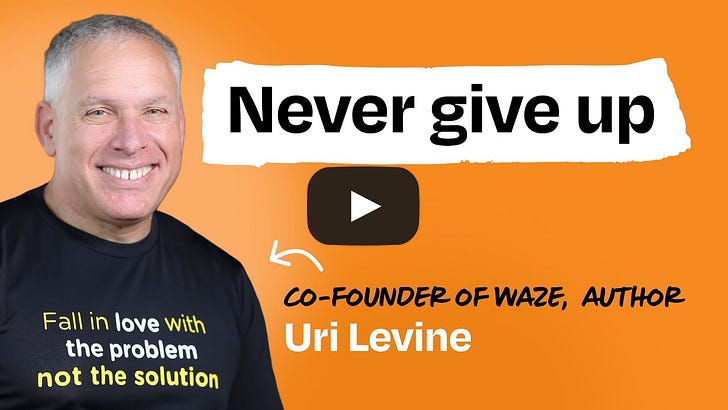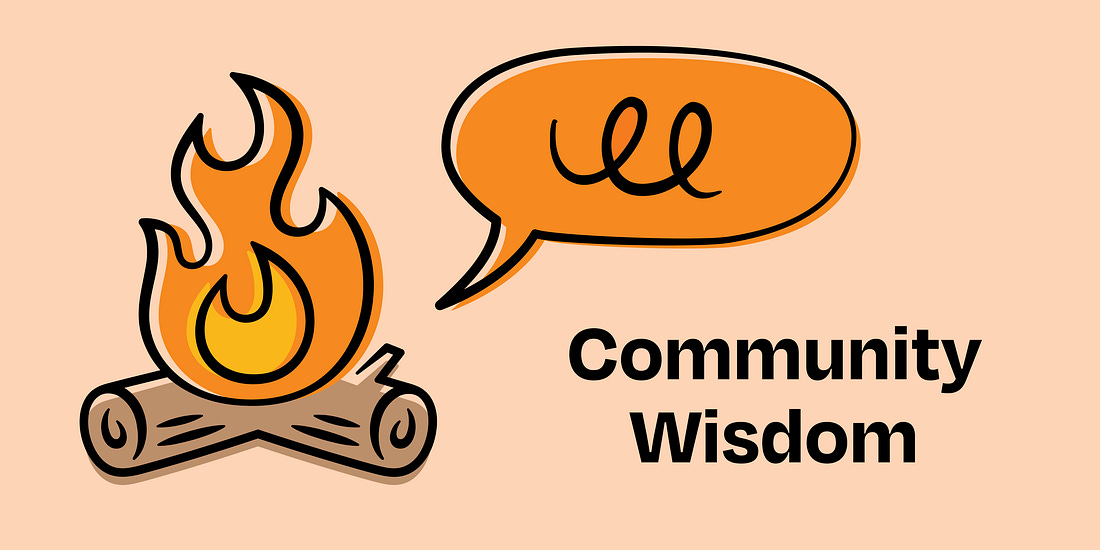🧠 Community Wisdom: Essential reading for early-stage founders, balancing unlimited SaaS plans with profitability…
👋 Hello and welcome to this week’s edition of ✨ Community Wisdom ✨ a subscriber-only email, delivered every Saturday, highlighting the most helpful conversations in our members-only Slack community. Also, don’t forget that as a paid subscriber, you get a year free of Perplexity, Notion, Granola, Superhuman, and Linear. A big thank-you to this month’s community sponsor, Chameleon. Tired of disruptive onboarding tools? Chameleon lets you guide users with inline, non-intrusive messaging that feels like part of your product, not a band-aid for bad UX. Deliver beautifully designed nudges tailored to each user’s journey, enhancing adoption and engagement without interrupting their flow. Chameleon is giving away a one-year Reforge membership at chameleon.io/lennys—check it out! 👫 Applications for the Spring 2025 Mentoring Program are now open!Apply by March 2nd. Before you apply, we encourage you to read the program overview to understand more about the program structure, timeline, and expectations. Please make sure you have time to meet with your mentor/mentee at least 3 times between March and May before applying. Ready to apply? Sign up here: Have other questions? Check out our FAQs or contact us! ✨ Upcoming community meetups ✨Upcoming community-organized meetups—click the city name to RSVP:
Can’t find your city and want to host one? Just DM @Riya in our Slack. It takes 10 minutes (i.e. pick a date and location), and you get to meet awesome people from our community. Learn more here. 🎙️ New podcast episode this weekA founder’s guide to crisis management | Uri Levine (Waze co-founder, serial entrepreneur): Apple, Spotify, and YouTube  💥 Top threads this week1. Balancing unlimited pricing plans with profitability
James Conway: Interesting problem to have!
Kourosh Ghaffari: Great ideas, @James Conway! I can’t offer a 30-day trial as some users will spend truly outrageous amounts of API credits within that time frame. Even a 7-day trial could result in wild costs to me. I can absolutely provide usage charts—great idea! Currently I offer about an hour of free recording time. Based on how fast the user reaches that hour, I can then figure out how much they would cost me in a month or so (plus a buffer). There’s an issue with interviewing my whales. And it’s a fun one: 9 in 10 of my whales use the software for ehmm… slightly adult purposes. They absolutely avoid having any interaction with me. Base price + overages plan could definitely work, but it’s technically frustrating to implement for me as a team of one. I’m trying to do anything else that I can before I attempt this. I also don’t necessarily love the base price + overages model as it doesn’t necessarily incentivise users to use my product as much as they can. Jenny Wanger: I’d be thinking about this slightly differently—the goal isn’t to have the costs of your whales covered by their own subscriptions, but rather to have your ARPU and ARPPU metrics under control (avg. rev per user and avg. rev per paying user). Under the previous plan, what were your ARPU and ARPPU? Were they both in the red, was one in the red? Kourosh Ghaffari: @Jenny Wanger, pricing has been live for less than 2 months now so a bit early to tell, but ARPU is around $7/m, and costs for avg. user are $2/m. But for a whale, the costs are around $15/m. Jenny Wanger: So what’s your ratio of whale paying users to non-whale? I did a quick chart—if you can have 80% of your users be avg. users, your ARPU:cost ratios get into the black. Obviously this may not be accounting for other costs, but point being there’s a ratio at which the standard users “subsidize” the whales. Kourosh Ghaffari: Hmm, very very interesting and helpful! Currently the whale count is through the roof because it got shared in a couple of forums where those whales operate. It’s just very scary to give unlimited access to a whale. 2. Essential reading for early-stage founders
Armen Arshakyan: I’ve read Zero to One and Lean Startup, and they have quite good examples of various cases. They’re also written in an inspiring way to not get bored. Both books provide a different outcome, though—Zero to One is more about high-level thinking, and Lean Startup goes a bit more on practical examples. I personally loved Zero to One more, since the question asked there stuck to my mind all the time: “What important truth do very few people agree with you on?” I believe the sole answer to this question can lead you to have a great startup idea. If you want to read more about experimentation, aha moments, and user research—you may also want to read Continuous Discovery Habits by Teresa Torres, a great book. Christian Sino: I think you would love Traction, by Gabriel Weinberg. Founder of DuckDuckGo. Beware there is a book with the same name from another author. Markham Nolan: This is recommended reading: https://www.amazon.co.uk/dp/1119594820/ref=cm_sw_r_as_gl_api_gl_i_2B6FW5CAEPSMVKNQ1TXA?linkCode=ml1&tag=expad-21. Super Pumped is worth reading, as is The Hard Thing About Hard Things. The Cold Start Problem is good. Tribe of Mentors has some good bits. Mohnish: Glad to hear you’ve also read Zero to One and Lean Startup. “What important truth do very few people agree with you on?” I believe the sole answer to this question can lead you to have great startup ideas. I also really liked this question, and you’ve shared a very interesting perspective to apply this question specifically to one’s startup idea. Sounds like a really nice way to touch upon what makes your offering unique. Anuj Adhiya: The Lean Startup wan’t that useful in practice for me. It’s more than ‘what.’ The ‘how’ is Running Lean by Ash Maurya and is the one to read. I’ve recommended it to every early founder who wants to figure out what needs to be done, in what order, to understand if they’ll get to PMF or not. Lu Doan: Not a book, but Starter Story is a great resource to gain the insights that you’re looking for. Def check out the Starter Story founder interviews on YouTube. They are full of golden nuggets. Christian Sino: Lu Doan, I hate that the landing page is so empty of resources and just asks me to give them an email. What are they giving me behind that? Lu Doan: @Christian Sino—It looks like SS moved to a paid-only model. The content is mainly case studies with founders. I would suggest starting with the interviews on their YT channel. Behind the SS paywall is more of that type of content. https://www.youtube.com/@starterstory David Jorjani: @Mohnish, what goals are you pursuing? Where are you in the journey? What problems are you facing? There are hundreds of great books and resources, but what helps you now is different what can help you in 6 months. People have mentioned some great books already. I’ll just add The Great CEO Within, by Matt Mochary, which can probably apply to any stage. Mohnish: @David Jorjani, these are good questions. Thank you very much for your valuable questions and ‘The Great CEO’ book suggestion.
3. Choosing between startup and big-tech design careers
Samantha Ingram: As a designer who’s worked at companies large and small for almost 25 years—do what you love. You will avoid burnout and have more curiosity for exploration and innovation. Don’t work a job you enjoy less to maybe someday get a job at a place you may or may not enjoy. The designers I know at FAANG companies definitely don’t all love their job. More don’t love them than do. While it feels amazing to say you work there, I’d always stick to what fills you up and inspires you. (And if you feel agitated reading that message—it’s a clear sign that preparing for FAANG companies is your priority. Listen to that.) Jason McCoy: Fwiw, FAANG companies may also not be a thing in 10 years, or at least they may not operate in the way they have for the past 20. AI is rapidly shifting roles, responsibilities, and operations, as well as overall market dynamics. I would prioritize doing work (and proactively identifying opportunities) that grows the business, establishing and improving your relationships with executive leadership, refining your visual craft and taste, and storytelling; these skills will always help you differentiate yourself. Călin: Both are viable career choices. You don’t need to be ex-FAANG to make it in the design world. In fact, if you have an entrepreneurial spirit, it’s better to work in startups and learn how to build 0-1 and find PMF because you can then apply that skill to your startups and make much more in the long run as a founder than climbing the corporate ladder. Great companies have been launched by designers. Airbnb, Linear, Maze, etc. Great designers make great founders. I find that path much more inspiring than Principal Designer at FAANG and dealing with corporate politics and red tape. 4. Balancing startup agility with corporate processes
Miroslav Pavelek: Here’s a great resource for additional context: Podcast: How to Build Your Product Team from Scratch – Rohini Pandhi (from this month). I listened to it yesterday, and it sparked some thoughts relevant to your challenge:
Akos Tolnai: It’s a culture thing. Try to find blogs that make distinctions of 0-1, 1-10, 10-100, 100-infinity. I don’t know if anyone did such comparison charts, but if you can’t find one, use any LLM to create one for you based on product blogs. If you are using Perplexity, you’ll have links to the resources. If this doesn’t help, it’s always good to ask why. Why should we build a process (if we don’t have the organization to man the process)? Why should we have KPIs, if the direction is always changing (pre-PMF)? Why do you need these? What is the risk that you can’t manage on your side with the current ops? (Your side means parent company in this context.) It’s internal stakeholder management. Nothing complicated, just use your PM tools on internal stakeholders (research, pattern recognition, intent analysis, etc.). Joni Hoadley: A design team’s objectives should directly contribute to delivering and communicating the value promised to customers. Without clarity on that, any objectives risk being vague or disconnected from the bigger picture. Here’s how I’d recommend approaching this: Make defining the value proposition your team-wide priority, and clearly communicate to stakeholders that this work is foundational. Without it, it’s impossible to create aligned objectives or measure meaningful progress.
Once the value proposition is clearer, objectives for the design team can be tied directly to achieving or amplifying this value.
It sounds like senior leadership from the parent org wants structured design goals, but the truth is that defining a value proposition is the prerequisite for setting meaningful objectives. Push back by explaining that:
Carlos: @Saurabh, adding to what others already mentioned above, I would start by saying that you are facing what I believe to be one of the most difficult challenges to overcome in product management. I would not underestimate the impact it could have. I have experienced this situation leading to shutting down the product and org. Do you know why the disconnect exists? In my previous experience, it’s lack of understanding of each other’s goals and constraints. If your background is startups/going from zero to one, you are aware of the need to be agile, test, measure, and pivot until you hit PMF. If your background is corporate, you are bound by budget cycles, reporting lines, org KPIs and/or performance targets. These different backgrounds can lead to a complete divergence in goals: your startup could be trying to create a successful product, while people in the parent org may be focused on hitting this year’s target because it’s tied to their bonus. This divergence compounds if the specific individuals within the parent work don’t have a big upside in case the startup succeeds (such as equity). So I would start by looking into what’s causing the disconnect. If you can share more details about that setup (how are the decision-makers in the parent org involved, what’s driving their decisions, what they get if your startup is successful, etc.), I’m happy to chip in with any insight I have. For context, I’ve done work in the past to address specifically this challenge due to my dual background—I’ve been focused on startups for the last few years (i.e. all about agility and finding PMF) but was a consultant for Accenture before (i.e. all about how corporations work). 🤓 Top finds
😂 Meme of the weekHave a fulfilling and productive week 🙏 If anyone in your life would benefit from this newsletter or community, consider giving them a gift subscription 💞 There are group discounts, gift options, and referral bonuses available. Sincerely, Kiyani 👋 Invite your friends and earn rewardsIf you enjoy Lenny's Newsletter, share it with your friends and earn rewards when they subscribe. |
Similar newsletters
There are other similar shared emails that you might be interested in:
- 🧠 Community Wisdom: Finding your voice on established teams, focus tips for ADHD brains, how to best use Granola,…
- 🧠 Community Wisdom: Designing great performance review templates, balancing oversight and autonomy with junior te…
- 🧠 Community Wisdom: 225th issue + balancing child care and career transitions, pregnancy disclosure in new roles,…

